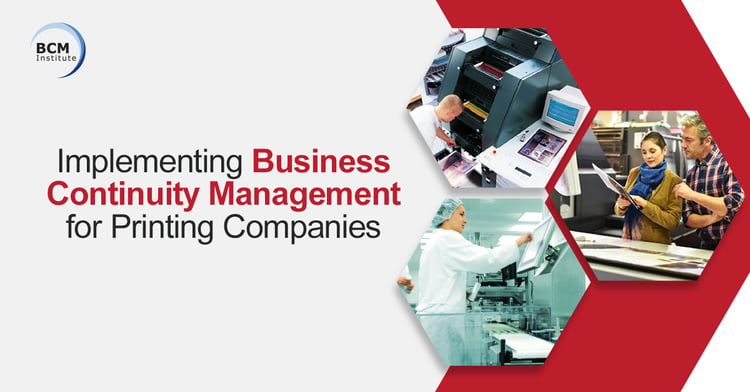Objective
The blog aims to share how business continuity management or BCM can be implemented and integrated specifically for printing companies. As the roles and functions of printing companies may vary depending on region and country, the core mission of the printing companies remains fairly unchanged with the exception on which part of the printing process that it is focusing on. A Printing Company in Singapore is used to provide context in this blog.
It is useful to ontroduce to the readers from the prinitng industry that there is a published international ISO BCM standard. The start of any BCM implementation based on the ISO 22301 BCMS standard starts with the "Understanding Your Organisation". This is where we provide an understanding of the "Printing Companies" in Singapore and the functionality within each printing companies.
What is a Printing Companies?
in spite of the digitization of work, a fact of life for almost any company is the need for paperwork to keep things running smoothly. Hence, whether it’s order forms, receipt blanks, brochures, advertising, or letterheads, a business that provides printing services will be able to help. Since the demand by each customer of printing services and its products will be different as it has its unique needs, a professional print company will work with each one on an individual basis to design and produce materials that meets its specific requirements and budget.
Another area where the expertise of printing companies can make a huge difference is in graphic design. It includes the layouts for flyers and other ads, the creation of logos, or brand development. It is even possible for printing companies to go “outside the box” and provide everything from custom printed drink-ware to T-shirts, staff name tags, and promotional items such as magnets, lanyards, and postcards.
The printing industry includes establishments primarily engaged in printing text and images on to paper, metal, glass, and some apparel and other materials.
Stages of Printing
Printing can be divided into three distinct stages:
- Pre-press
-
Prepare editorial and ad materials
-
Build page layout
-
Make film and plates (or plates only)
-
- Press or Output
-
"Make-ready" the press
-
"Color-ready" or "come up to color"
-
Get ready or permission to print
-
Print
-
- Post-press or Finishing
- Fold, bind, and trim printed sheets into their final form
- Bind accordingly (e.g. perfect stitched and perfect bound)
-
Prepare finished pieces for retail sale
-
Pack for final distribution via postal entry and/or single-copy sales
Companies that provide all three services first prepare the material for printing in the pre-press department, then produce the pages on the press-room floor, and finally trim, bind, or otherwise ready the material for distribution in the post-press department.
Increasingly, printers also are providing database management, mailing, or distribution services to meet customer needs.
A wide range of products are produced in the printing industry. In addition to magazines, books, and some small newspapers, other examples of printed products include direct mail, labels, manuals, and marketing material. Less obvious printed goods include memo pads, business order forms, checks, maps, T-shirts, and packaging. The industry also includes establishments that provide quick printing of documents for the consumer or support services, such as pre-press, embossing, binding, finishing, and mailing.
Sample Organisation Structure of A Printing Company
This is a sample organisation chart for a printing company. It is essential during the implementation of business continuity to consider not only the main printing process (manufacturing) but to consider the rest of the functions such as finance, human resource, sales and marketing.

Beside the project Manager (or Organisation BCM Coordinator), the number of participants for a typical project will start with the appointment of a Business Unit (BU) BCM Coordinators from each business unit. It can be estimated based on a sample organisational structure as highlighted above
Reading "Business Continuity Management: What is My Role?" may help you understand the BCM roles within the a printing company implementing BCM.
Business Functions (Product and Services) for Printing Companies
In the context of business continuity management, the clear understanding of its business functions which could be printing companies operations and its mandated "services" or "product" to its specific customers.
Since printer will be different and have unique needs, a professional print company will work with each one on an individual basis to design and produce materials that meets its specific requirements and budget. The final cost can often be less than what one would pay to produce these items in house. These are some of the common printing services.
[1] Digital Printing
In digital printing, printers are used to reproduce digital images on the physical surface, such as paper, film, cloth, plastic, etc. The printers that are widely used these days are inkjet and laser printers.
[2] Flexography
This type of printing is commonly used for packaging. The surface of the printing plate is coated with ink and the print surface will rotate. This will contact the print material which will transfer the ink.
[3] Letterpress Printing
The text is printed with a movable type. The raised surface of the type is inked and this will be pressed against a smooth substance to obtain an image in reverse. They are used for printing books, letterhead, posters, newspapers and business cards.
[4] Offset Printing
It is a commercial printing process used for desktop publishing on paper. They are also used in sheet-fed and web offset presses.
[5] Screen Printing
This type of printing is used on hats, ceramics, polyethylene, polypropylene, glass, T-shirts, paper, metals, and wood.
[6] Scanner/Photocopier
A printer takes the place of a scanner and a photocopier for some offices. Scanners will capture an image from a printed page, both text and images, and convert them into digital format.
A photocopier makes a reproduction of text and images and prints out the results. Like with printing, you are looking for how quickly the multi-function printer produces copies and scans. Since you want scans and photocopies that are accurate, the resolution of the scan or photocopy needs to be high so the copy looks like the original.
Identifying Business Functions
The business functions highlighted so far are mainly focus on "customer" facing and the designated BCM team should not forget to include the business functions that is required for the operations of the printing companies. These includes human resources, finance, administration, sales and marketing
Crisis and Disaster
Another consideration to further understand the organisation, is to identify the types of events that may disrupt the printer companies ability to continue its roles and responsibility. Read " What Are the Basic Concepts Needed for Business Continuity & Crisis Management?" for a better understanding of the terminology.
Crises in Printing Companies
Within a printing companies, a crisis could occur at any moment. A crisis is a critical event that may impact an organization's reputation or ability to operate. However, it does not deny access to facility and infrastructure. Crises relating to printing companies can include:
- Competition among other printing companies
- Lack of papers
- Lack of ink/toners
- Machine malfunction
- Decrease usage of paper based material
Disasters in Printing Companies
Like crises, disasters can hinder an organization. However, in such events, access to facility and infrastructure is denied.
Disasters relating to Printing Companies can include:
- Fires
- Floods or another type of severe weather-related conditions
- Terrorist attacks
- Loss of information technology services
- Pandemic Influenza or Infectious Diseases
- Denial of access or damage to facilities.
If you find the managing of crisis and disaster confusing, this article "What is Crisis Management Vs Business Continuity Management? Often Confused" may help you understanding the concept better.
BCM Planning Methodology
The next blog will provide you with the "Planning Steps for Implementing BCM for Printing Company". You will have an good overview of the steps to be taken and lastly, what competency should you have with funding from the Singapore government.
References
(What are the different stages of Print Production?, 2013)
(Prepressure)
(What can a print company do for a small business?)

How To Be BCM Competent and Where Do I Start?
If you are a Singapore-based company or Singaporean and Permanent Resident, you can opting to received training via:
- Singapore Workforce Skills Qualifications (WSQ) Course Code: BCM-310; 320;330]
- CITREP+ Critical Infocomm Technology Resource Programme PLUS (CITREP+)




